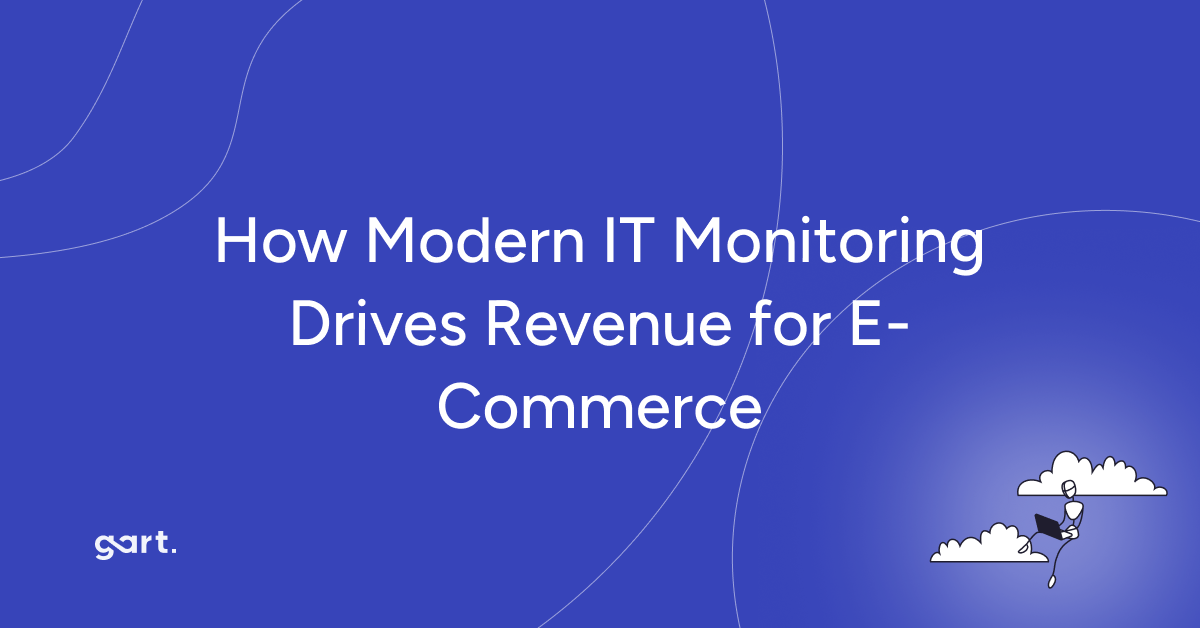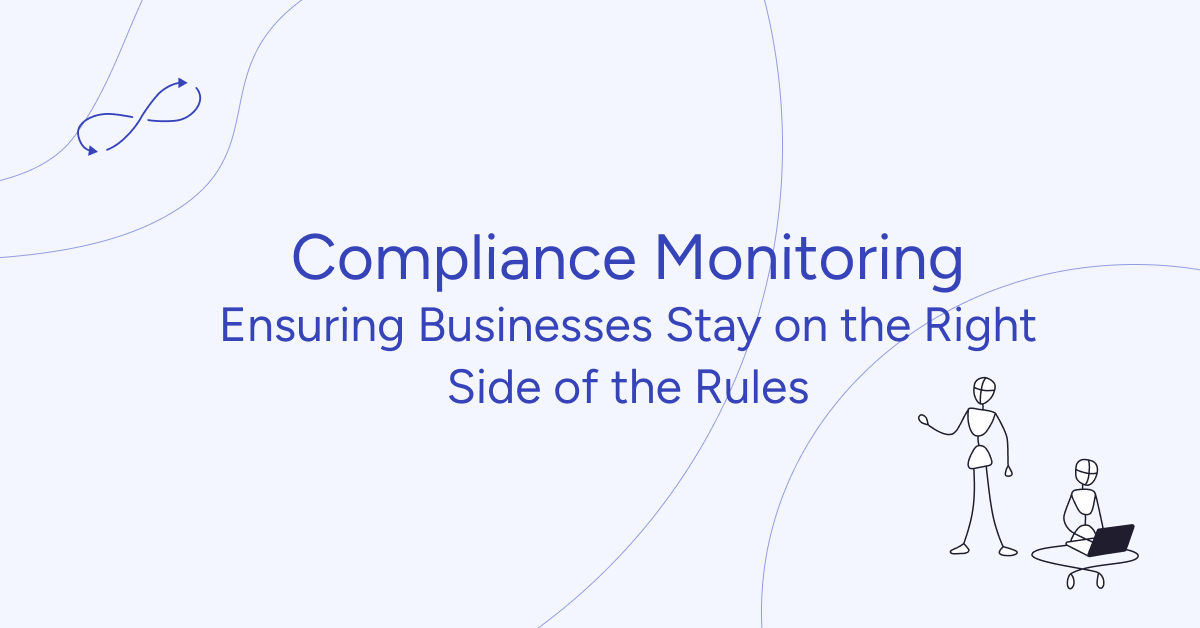Let’s get real: just because your servers are smiling green on the dashboard doesn’t mean your cash register is too. In the wild world of e-commerce, “100% uptime” is basically the IT version of saying, “I woke up today.” Nice, but it doesn’t pay the bills.
Here’s the deal—your dashboards can scream All Systems Green, while your revenue and customer happiness are waving the Red Flag. Modern monitoring isn’t about patting your servers on the back—it’s about protecting your profits, optimizing costs, and making customers happy.
The Disconnect: All Systems Green, Revenue Red
Old-school monitoring is obsessed with CPU, memory, disk, network—you know, the usual suspects. The system says, “We’re good!” Meanwhile, a tiny hiccup—a 2-second lag at checkout—can cost you thousands in abandoned carts.
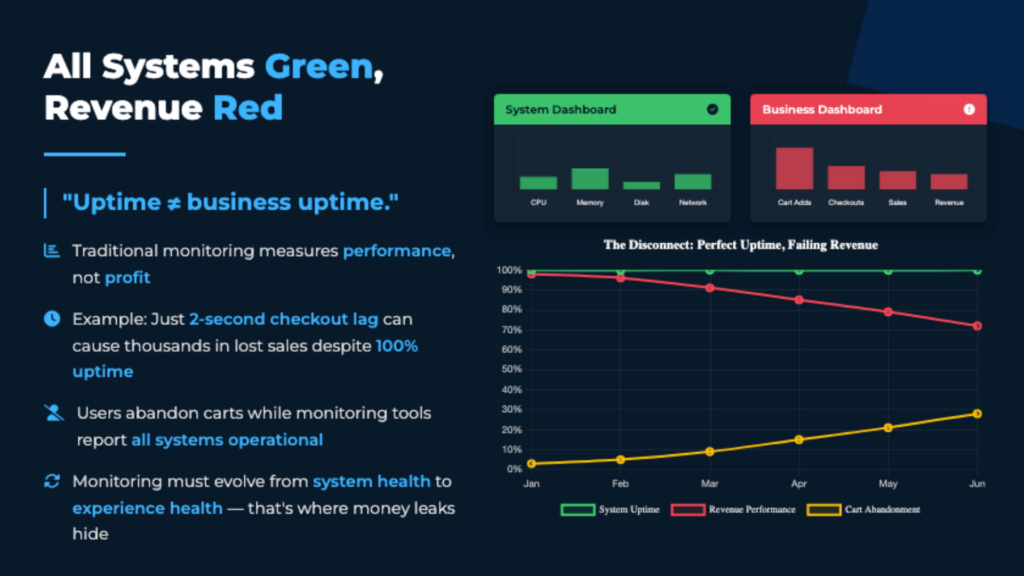
Classic problem: Monitoring measures tech health. Not profit.
Modern monitoring flips the script:
- Old Question: “Is the server up?”
- Modern Question: “Are we making money and keeping users smiling?”
Think of it as moving from system health to experience health—because that’s where revenue leaks hide.
The Modern Monitoring Mindset: Holistic & Proactive 💡
A modern e-commerce monitoring strategy is built on four core principles, ensuring it covers the entire spectrum of business operation, not just the infrastructure (as visualized in the coverage gap between Traditional and Modern Monitoring).
| Feature | Old Mindset (Reactive) | Modern Mindset (Proactive) |
| Trigger | Alert after something breaks (Reactive). | Predict issues and prevent revenue loss (Proactive). |
| Focus | Servers, APIs, Technical Health. | Users, Revenue, Experience. |
| Alerts | Too many alerts, high fatigue, low context. | Reduced noise, context added (e.g., cost at stake). |
| Value | Basic stability (keeping systems running). | Protecting profit and driving growth (using data smartly). |
Bottom line: you don’t need more data. You need smarter insights that tie backend stuff to cash in the register.
Core Principles
- Holistic: It combines infrastructure, application, product, and business metrics into a single, cohesive view.
- Proactive: The primary goal is to anticipate failures and protect revenue, not merely react after an outage.
- Dual-Language Fluent: It must speak to engineers using technical terms (latency, errors) and to executives in terms of revenue and cost.
- Outcome-Focused: It tracks metrics that truly matter to the business, such as conversion rates, MRR, churn, and cost per customer.
Business-Critical KPIs to Monitor
To turn monitoring into money, you must measure metrics that have a direct impact on your bottom line. These key performance indicators (KPIs) tie technical performance directly to financial outcomes.
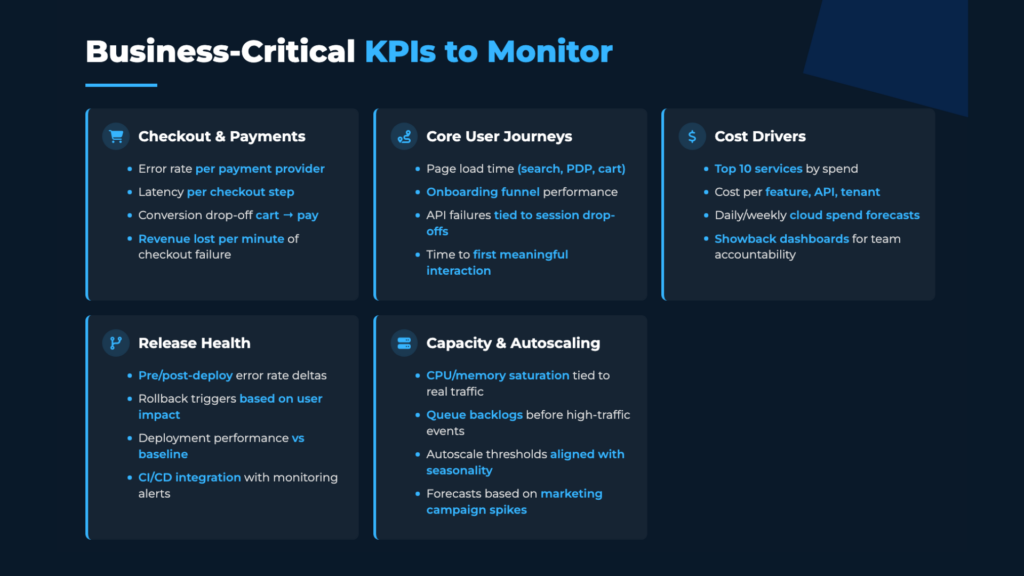
1. Checkout & Payments
These are direct revenue flow metrics.
- Revenue Lost per Minute: The immediate financial impact of a failure.
- Cart to Pay Conversion Drop-off: Identifying where customers abandon the most critical step.
- Error Rate per Payment Provider: Pinpointing unreliable payment gateways.
2. Core User Journeys
The technical experience of the user translated to business impact.
- Page Load Time for critical areas (Search, Cart).
- API Failures tied directly to session drop-offs.
3. Cost Drivers
Moving beyond total spend to understand expenditure efficiency.
- Cloud Spend Trends: Monitoring cloud usage patterns over time.
- Cost per Feature/API: Making teams accountable by knowing the exact cost to run each core function.
- Showback Dashboards: Providing transparency on cloud usage to engineering teams to drive optimization.
4. Release Health
Monitoring for business impact immediately after deployment.
- Pre/Post-Deploy Error Rate Deltas: Quickly detecting new bugs introduced by a release.
- Rollbacks Triggered by User Impact: Automating failure response based on revenue/conversion drops, not just system errors.
5. Capacity & Autoscaling
- Autoscaling based on Revenue Metrics: Ensuring resources scale up when high-value traffic arrives, not just when the CPU hits a limit.
🛠️ The Modern Monitoring Architecture Blueprint
A solid blueprint integrates data from three main layers to provide the holistic view required.
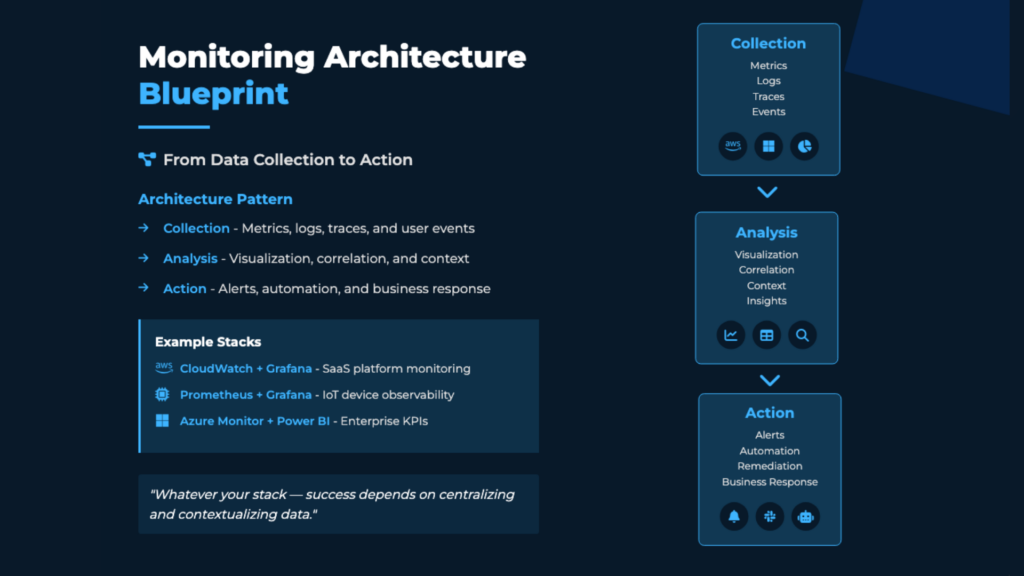
1. Data Collection Layer (The Sensors)
This layer captures all raw data from across the system:
- RUM (Real User Monitoring): Tracks what real users experience in the browser (e.g., actual page load times).
- APM (Application Performance Monitoring): Traces every transaction inside the code to find bottlenecks.
- Business KPIs: Data pulled directly from CRM, payment dashboards, and analytics (e.g., Google Analytics).
2. Data Processing Layer (The Brain)
Using tools like Prometheus and Grafana, this engine connects the data:
- Correlation: Matches a technical event (e.g., slow database query) with a business impact (e.g., rise in cart abandonment).
- Anomaly Detection: Predicts issues by learning what “normal” behavior looks like and spotting small, unusual changes before they become failures.
3. Insight & Action Layer (The Output)
Data is translated into actionable business value for two key audiences:
- Engineers: High-context, actionable alerts that can trigger automation like auto-scaling or rollbacks.
- Executives & Finance: Product-aware dashboards showing revenue per minute, conversion rates, and cost efficiency.
AI and Data: Turning Noise into Profit
If data were treasure, modern e-commerce platforms would be overflowing pirate ships. The problem? Most of it is just noise—alerts, logs, metrics—flying at you like cannonballs. That’s where AI and Machine Learning come in. They don’t just sort the chaos; they turn it into actionable insights that protect revenue, optimize costs, and save you hours of panic-fueled debugging.

Anomaly Detection: Spot the Sneaky Stuff
Think of it as having a radar for the tiniest problems before your users even notice. A spike in checkout latency, a subtle API hiccup, or a quiet but costly payment failure—AI spots it all. Traditional monitoring might shrug at a minor blip, but ML sees patterns and predicts revenue leaks before they hit the bottom line.
Noise Reduction & Correlation: Fewer Alerts, More Clarity
Every failed API, slow query, and server timeout can trigger alerts. And suddenly, your engineers are drowning in notifications. AI consolidates these scattered signals into a single, crystal-clear alert: “This is the problem. Fix this first.” Less noise means faster action, less burnout, and more focus on what really matters—keeping users happy and cash flowing.
Intelligent Forecasting: Be Ready Before the Storm Hits
Seasonal peaks, marketing campaigns, viral product launches—these are the storms your e-commerce ship must survive. AI doesn’t just react; it predicts. By analyzing historical data and spotting trends, it helps you plan server capacity, auto-scale resources, and avoid overspending on cloud infrastructure. In short, you’re prepared, not panicked.
The Bigger Picture
AI and ML don’t replace humans—they supercharge them. Engineers can focus on creative problem-solving, product teams can fine-tune the experience, and executives get real-time insight into how technical hiccups are affecting revenue. The result? Monitoring stops being a reactive chore and becomes a revenue-protecting, growth-driving engine.
In the world of modern e-commerce, turning noise into gold isn’t optional—it’s essential. Without it, your business might think everything is fine until the bottom line says otherwise. With it? You’re proactive, profitable, and a step ahead of the chaos.
Defining Thresholds as Business Decisions 🎯
The secret to turning monitoring into an investment is setting thresholds tied directly to the cost of failure, not just technical limits.
| Threshold Type | Definition | Action | Business Impact |
| Warning Rate | Metric is starting to degrade (e.g., API latency > 1.5 seconds). | Automatic, non-human action. E.g., trigger auto-scaling to inject resources. | Prevent user experience failure and revenue impact. |
| Critical Action | Business is actively losing significant money (e.g., Checkout failure rate > 1%). | Immediate high-priority alert to Operations team. | Contain and recover significant revenue loss right now. |
| Financial Action | Cloud cost spike of 15% outside known campaigns. | Immediate investigation by Finance and Engineering. | Prevent budget overrun and optimize costs. |
Export to Sheets
The ROI of Modern Monitoring
Treating monitoring as a growth investment requires a clear formula for the Return on Investment:

The numerator represents the direct profit and efficiency gains:
- Recovered Revenue: Revenue put back into the business by catching checkout errors, payment failures, and session drop-offs.
- Saved Costs: Money saved from avoiding cloud waste through resource right-sizing and optimization.
- Saved Time: Engineering time saved due to faster debugging, better-contextualized alerts, and automated recovery.
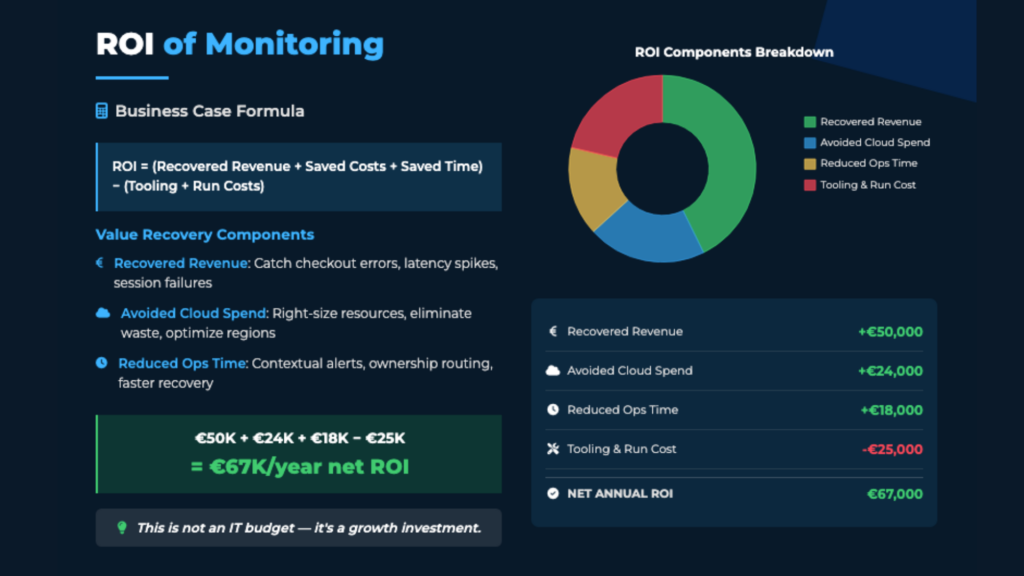
By focusing on these metrics, monitoring stops being an IT cost center and becomes a direct contributor to the bottom line.
Adopting the Modern Approach
E-commerce businesses can achieve visible, measurable ROI within 60 days by focusing on a targeted rollout:
- Phase 1 (Weeks 1-2): Discovery & Executive Dashboards:
- Pinpoint the top three revenue flows (Search, Cart, Checkout).
- Instrument key business metrics immediately.
- Create executive dashboards showing Revenue per Minute alongside technical health.
- Phase 2 (Weeks 3-4): Cost Visibility & Ownership:
- Integrate cloud billing metrics to track Cost per Feature.
- Define clear Service Level Objectives (SLOs) and Indicators (SLIs) to stop alert fatigue and ensure the right team gets the right context.
- Phase 3 (Weeks 5-6): ROI Realization & Automation:
- Enable autoscaling based on revenue metrics, not just CPU.
- Implement pre- and post-deploy checks that automatically look for revenue drops after a release.
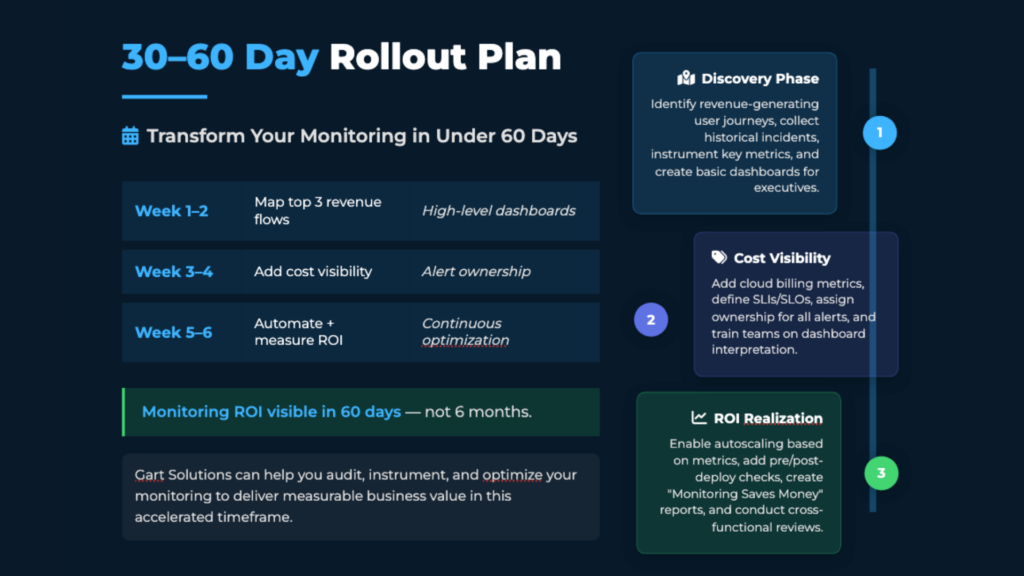
Ultimately, the shift is simple: Stop measuring only system uptime and start measuring business uptime.
30-60 Day Rollout Plan: Achieving ROI Fast
Gart Solutions focuses on delivering visible, measurable monitoring ROI in 60 days—not 6 months. This accelerated approach prioritizes the most valuable areas first.
| Phase | Duration | Focus Area | Key Actions | ROI Deliverable |
| Phase 1 | Weeks 1-2 | Discovery & Executive Alignment | Pinpoint top 3 revenue flows (Search, Cart, Checkout). Immediately instrument key business metrics. | High-level Executive Dashboards showing Revenue per Minute alongside technical health. |
| Phase 2 | Weeks 3-4 | Cost Visibility & Ownership | Add cloud billing metrics to track Cost per Feature/API. Define clear SLOs and SLIs to eliminate alert fatigue. | Showback Dashboards for engineering teams, driving accountability and initial cost savings. |
| Phase 3 | Weeks 5-6 | ROI Realization & Automation | Automate action based on business metrics (e.g., auto-scaling based on conversion drops). Implement pre/post-deploy checks that look for revenue impact. | Automated issue prevention and measurable revenue protection. |
Gart Solutions Services: End-to-End Monitoring Consulting
Gart Solutions provides end-to-end monitoring consulting focused on measurable business impact across three areas: Save Money, Prevent Churn, and Improve Speed.
The core service offerings include:
- KPI Mapping: Aligning your business goals with the right measurable metrics (e.g., matching latency to conversion drop-off).
- Architecture Design: Building scalable monitoring stacks that are often cloud-agnostic to avoid vendor lock-in.
- Implementation: Seamless integration of RUM, APM, and Business KPIs into a unified system.
- Cost Visibility: Creating transparent, cost-aware dashboards for financial impact and cloud optimization.
- Training & SRE Services: Empowering internal teams to maintain and continuously optimize the new monitoring system and build robust infrastructure.
To begin protecting your profit and improving your margins, the first step is simple: Stop measuring only system uptime and start measuring business uptime.
See how we can help to overcome your challenges

